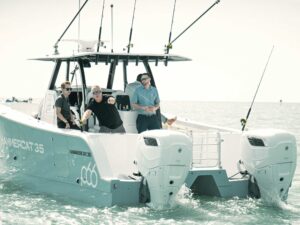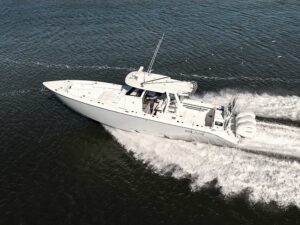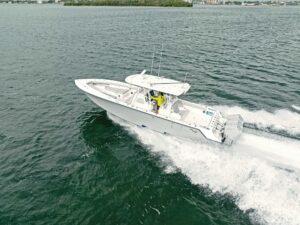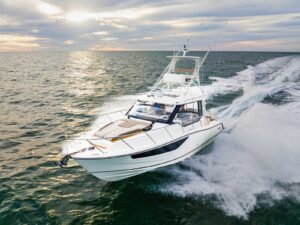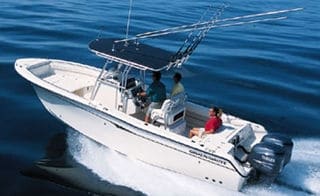
The newest Grady started its career as the highly respected 263 Chase. The 263’s hull was revamped a few years ago when the step in the bottom was faired off and the bottom extended to provide a longer running surface. Still, the model name and number stayed the same.
Now the deck and interior layout have also undergone a redesign, and the result is an improved fishing and cruising machine measuring 26 feet, 11 inches. It also has a new name – the Chase 273.
Just to keep priorities straight, Grady started modifications at the fishing end, in the transom/cockpit area, paying particular attention to the live well and fishbox arrangement. In an earlier incarnation, the fishbox was located up front. It held fish, but was less than convenient to reach when the action got hot and heavy. In the redesign, the185-quart insulated fishbox has been molded into the transom, where it’s at waist level and easy to reach.
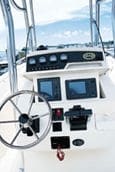
Lots of builders have wrestled with the transom-seat dilemma: How do you make it convenient when running, yet out of the way once the fishing begins? Grady seems to have worked out an especially slick and efficient system that answers the challenge. An ingenious mechanical arrangement allows the seat to fold flush against the transom, beneath the cockpit bolster, where it’s out of the way until needed. The same hinge mechanism allows the seat to be lifted up onto the fishbox to provide access to the bilge via the hatch in the lower section of the transom. It’s an arrangement that really works.
On the port side of the transom bulkhead is a 38-gallon, round live well that drains overboard. It’s plumbed to an 1100-gph pump, and fills via a full-column inlet system. This provides floor-to-surface circulation, eliminating dead water in the well. A red light inside the well keeps the bait calm when you open the lid (according to the manufacturer), and also preserves your night vision when fishing after dark. To starboard, the transom door hangs from oversized hinges and provides access to the platform, which is equipped with an integrated swim ladder.
Under-gunwale rod racks on both sides of the cockpit hold up to six rods each, including fly rods to nine feet. Entire conventional rod-and-reel outfits can be concealed behind lockable, hinged covers for security. Four flush-mount rod holders, two on each side in the covering boards, are standard. The optional T-top on our test boat provided an overhead storage net for beach gear or PFDs, and had four additional rod racks.
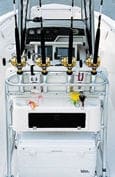
The leaning post/rocket launcher has also undergone improvement, mostly in details such as pliers and drink holders. Notable is a step bar on either side between the support legs, which makes it easy to reach the T-top rod holders.
At the helm, an electro-mechanical instrument panel rises from the top of the control station ahead of the steering wheel, placing the electronics at a convenient viewing level. But more importantly, this same system lowers the electronics into hiding when not in use, keeping them secure and protected from the elements.
The oversized console provides abundant storage and houses a sink hooked up to the 20-gallon fresh water tank. There is also enough room for a head, if desired.
In the bow, the combination of fishing efficiency and cruising comfort really come together. Twin insulated fishboxes flank a removable center platform – under which there is room to stow a cooler and cast-net bucket – creating a wide, raised casting deck. Remove the insert and you have cockpit-level access to the bow for anchoring chores or fighting fish. All boxes drain overboard, not into the bilge. Even the drink holders drain onto the cockpit sole, then into scuppers in the self-bailing cockpit and overboard.
Weather on our test day was a good-news/bad-news story. From the protected docks at Duck Key in the Florida Keys we headed out to the reef in conditions that, love ’em or hate ’em, provided an honest test of any boat’s ability to deal with real-life seas. A heavy chop inshore gave way to three- to four-footers just inside the reef, but the 273 ate it up, taking the sloppy stuff in stride. The foamed-in stringers provide a rock-solid feel, while the hydraulic trim tabs allow for on-the-run balancing and smoothing out of the ride.
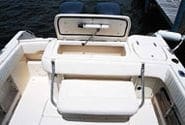
Our test boat was powered by dual F200 Yamaha four-strokes, which, according the manufacturer’s figures, provide an optimum cruising speed of 27.3 mph at 3500 rpm, sipping just over 13 gallons per hour. Top speed is 46.3 mph at 6100 rpm.
The standard-equipment list on the 273 includes trim tabs, the leaning post/rocket launcher, raw-water wash-down, cockpit shower, and more – everything you need to fish in style. Add a few options, such as the T-top and console head, and you have a whole lot of fishing boat in a 27-foot center console.
Grady-White Boats, Greenville, NC; (252) 752-2111; www.grady-white.com.
| ¿ SPECIFICATIONS Length: 26′ 11″ Beam: 8′ 6″ Draft: 15″ Max. hp: 500Fuel: 205 gals. Water: 20 gals. Weight w/o engine: 3,975 lbs. Base price w/ dual Yamaha 150-hp HPDI outboards: $80,750 w/ dual Yamaha F200 four-stroke outboards: $89,328 |

